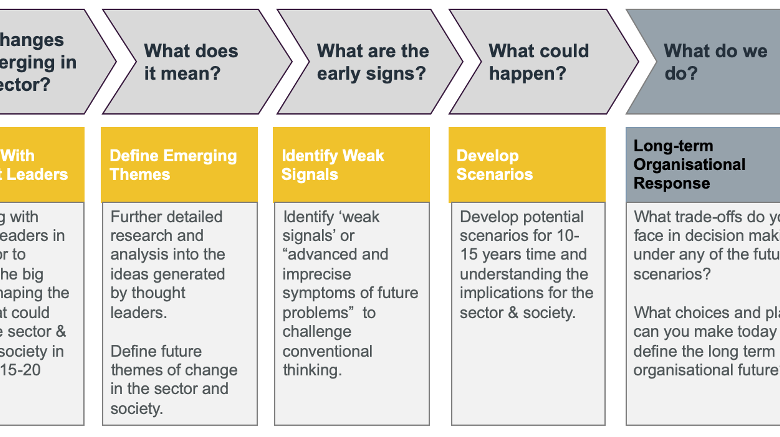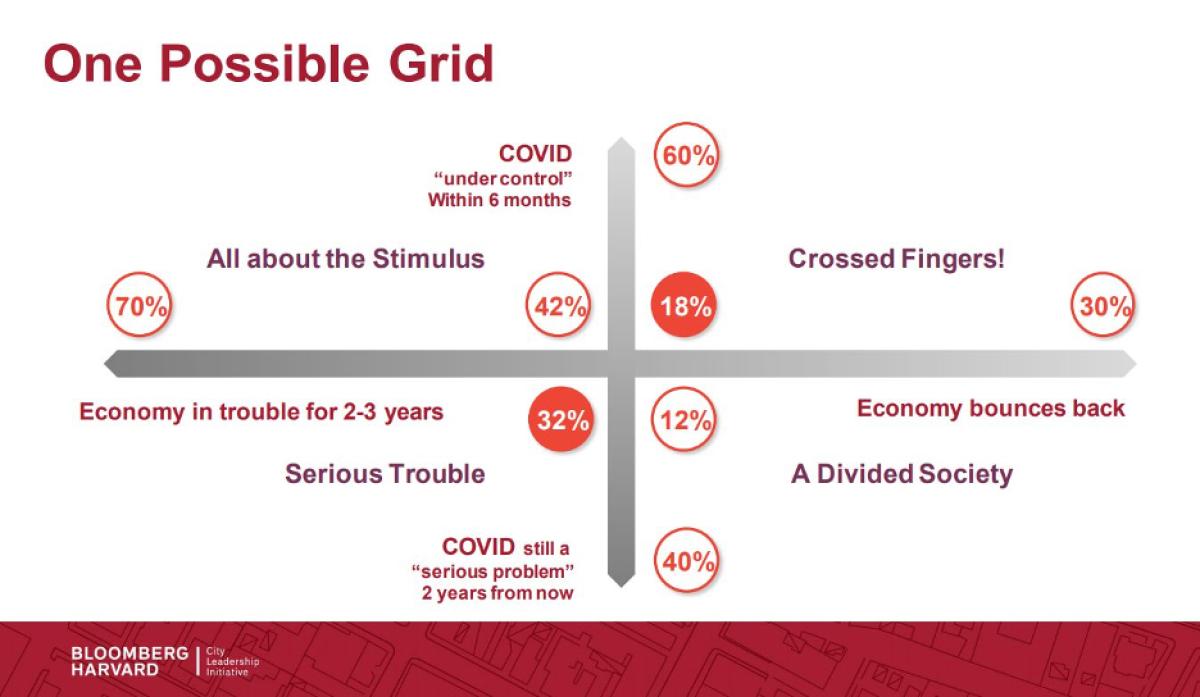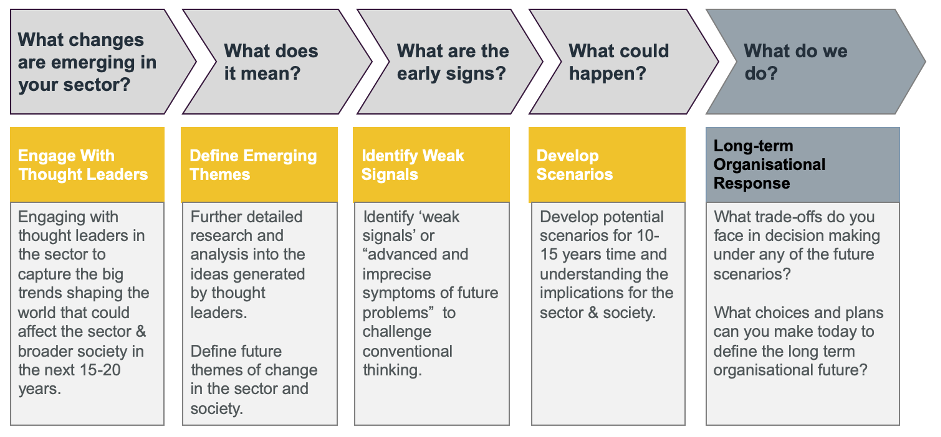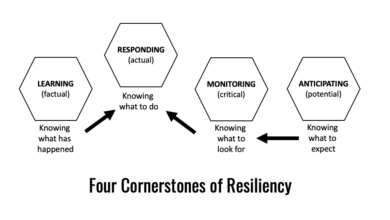
Scenario Planning During Coronavirus Crisis A Post-Pandemic Look
Scenario planning during coronavirus crisis offers a fascinating lens through which to examine the pandemic’s impact. This post delves into the process of developing and analyzing potential scenarios, highlighting the challenges, opportunities, and key lessons learned. We’ll explore how businesses and industries might have approached the crisis with proactive planning, and what insights from this unique period can be applied to future crises.
The pandemic presented unprecedented challenges, requiring a nuanced approach to strategic planning. This analysis examines the different scenarios that could have been considered, including supply chain disruptions, evolving consumer behavior, and the impact of technological advancements. By understanding the various potential outcomes and the factors influencing them, organizations could have better prepared for and responded to the crisis.
Introduction to Scenario Planning
Scenario planning is a strategic tool used to anticipate potential future developments and prepare for a range of possible outcomes. It goes beyond simple forecasting, focusing instead on exploring multiple plausible futures and their implications for an organization. It’s a structured process of envisioning different “what if” scenarios and evaluating their impact. This allows for more robust decision-making and preparedness, especially in uncertain times.This method enables organizations to anticipate challenges and opportunities, and to develop adaptive strategies.
By understanding the potential implications of different futures, businesses can adjust their operations, allocate resources, and refine their objectives accordingly.
Definition of Scenario Planning
Scenario planning is a structured process of imagining multiple plausible future states. It explores a range of possible futures by identifying key uncertainties and their potential interactions. The goal is to understand the possible consequences of these scenarios and develop strategies that are robust across different outcomes. It’s not about predicting the future, but about understanding the range of possibilities and preparing for them.
General Principles of Scenario Planning
Scenario planning relies on several key principles. First, it recognizes the inherent uncertainty of the future. Second, it focuses on identifying key uncertainties, those factors that could significantly impact the future. Third, it develops a set of plausible scenarios that incorporate the identified uncertainties and their potential interactions. Finally, it evaluates the implications of each scenario for the organization and develops strategies to adapt to different outcomes.
Importance of Scenario Planning in a Crisis
In times of crisis, like the COVID-19 pandemic, scenario planning becomes crucial. It allows organizations to anticipate a wide range of possible impacts and develop contingency plans. This proactive approach can help minimize disruptions and facilitate a quicker recovery. Scenario planning enables organizations to be more agile and adaptable, crucial during periods of rapid change and uncertainty.
Historical Context of Scenario Planning
Scenario planning’s roots lie in military strategy, with early applications focusing on national security concerns. The Royal Dutch/Shell Group is widely credited with pioneering its use in the business world in the 1970s. Their foresight in anticipating the oil crisis through scenario planning illustrates the value of the method in navigating unpredictable events. The methodology has since been adopted by numerous organizations across various sectors.
Examples of Pandemic Scenarios
| Scenario | Description | Potential Impacts |
|---|---|---|
| Global Pandemic with Strict Lockdowns | Significant restrictions on movement and economic activity across the globe. | Significant economic downturn, supply chain disruptions, increased unemployment, and potential social unrest. |
| Regionalized Pandemic with Localized Lockdowns | The pandemic impacts specific regions or countries more severely than others, leading to uneven economic and social outcomes. | Disrupted trade and investment flows, regional economic disparities, and challenges in global supply chains. |
| Vaccine-Resistant Variant Emerges | A new variant of the virus emerges that is resistant to existing vaccines. | Prolonged pandemic, resurgence of infections, and the need for new vaccine development. |
| Pandemic with a Gradual, Sustained Economic Impact | The pandemic impacts economic activity for a prolonged period, leading to sustained recessionary pressures. | Slow economic recovery, potential job losses, and long-term impacts on consumer confidence and investment. |
Scenario Development during the Coronavirus Crisis: Scenario Planning During Coronavirus Crisis
The COVID-19 pandemic presented unprecedented challenges and opportunities for organizations seeking to anticipate future possibilities. Traditional scenario planning methods, often relying on historical data and predictable trends, were severely tested. The rapid and unpredictable nature of the pandemic required a more dynamic and adaptive approach. This demanded a nuanced understanding of the evolving situation and the ability to quickly adjust assumptions and explore new possibilities.Scenario planning during this period demanded a shift in perspective, recognizing that the crisis itself was a significant driver of future uncertainties.
Organizations needed to move beyond simply considering “what ifs” and delve into the potential impacts of the pandemic on various aspects of their operations, supply chains, and markets.
Challenges in Developing Scenarios
The rapid evolution of the pandemic created significant obstacles in developing accurate and relevant scenarios. Data availability was often limited and unreliable, especially in the early stages. The unprecedented nature of the crisis made it difficult to establish clear cause-and-effect relationships, hindering the creation of robust and credible scenarios. Furthermore, the global nature of the pandemic complicated the process, requiring the integration of diverse perspectives and experiences.
Limitations and Opportunities During the Pandemic
The pandemic exposed limitations in existing planning frameworks. Traditional methods often failed to account for the unpredictable and interconnected nature of the crisis. However, the crisis also highlighted the value of agility and adaptability. Businesses that were able to rapidly adjust their strategies and operations based on evolving circumstances were better positioned to navigate the challenges. Real-time data collection and analysis became critical for scenario development.
Factors Impacting Scenario Development
Several factors significantly influenced the development of scenarios during the pandemic. These included the evolving public health restrictions, economic downturns, supply chain disruptions, shifts in consumer behavior, and the rapid adoption of digital technologies. The pandemic highlighted the interconnectedness of global markets and the need for businesses to consider the ripple effects of their decisions on a broader scale.
This realization fostered a greater awareness of global risks and vulnerabilities.
Potential Scenarios for Businesses
Understanding the impact of the pandemic on businesses required careful consideration of potential scenarios. These scenarios should have addressed the disruptions to supply chains, shifts in consumer demand, and the adoption of new technologies. It was crucial to anticipate how these factors would interact and evolve over time.
- Supply Chain Disruptions: The pandemic significantly disrupted global supply chains, leading to shortages of essential goods and increased transportation costs. This forced businesses to consider alternative sourcing strategies and build resilience into their operations. Scenarios might have explored the potential for long-term supply chain restructuring or the emergence of new regional supply hubs.
- Consumer Behavior Shifts: The pandemic accelerated the adoption of digital technologies and changed consumer behavior. Scenarios should have considered the potential for permanent shifts in online shopping, remote work, and contactless interactions. The rise of e-commerce and the changing needs of consumers in a remote environment could have been incorporated into the scenarios.
- Economic Downturn: The pandemic led to a global economic downturn. Scenarios should have considered the potential for prolonged recession, increased unemployment, and reduced consumer spending. This would have allowed businesses to prepare for the possibility of a prolonged economic downturn.
Scenario Table
This table Artikels potential scenarios, their potential impacts, and the key drivers.
| Scenario | Potential Impacts | Key Drivers |
|---|---|---|
| Supply Chain Resilience | Businesses with robust supply chains experienced minimal disruption, adapting quickly to new regulations and demand. | Strong supplier relationships, diverse sourcing, and proactive risk management. |
| Digital Transformation Acceleration | Companies that embraced digital technologies saw increased efficiency and profitability, while those that lagged fell behind. | Adoption of cloud-based solutions, digital marketing, and remote work tools. |
| Economic Recovery Lag | A prolonged economic downturn impacted consumer spending and business profitability. | Global economic instability, reduced consumer confidence, and delayed recovery in certain sectors. |
Analyzing the Impacts of Different Scenarios
Scenario planning during the COVID-19 crisis demanded a deep dive into potential futures. Beyond simply identifying possible paths, the crucial step was understanding the ripple effects of each scenario on various sectors. This analysis required careful evaluation of likelihood, impact, and the intricate interplay of uncertainties.Evaluating scenarios involved a multifaceted process, requiring both quantitative and qualitative assessments. This included considering the probability of each outcome based on historical data, expert opinions, and emerging trends.
Discover how cima ethics confidentiality rules has transformed methods in this topic.
The potential impact was measured in terms of economic consequences, social changes, and shifts in consumer behavior. Complex interactions between these factors were essential to understanding the interconnectedness of different scenarios.
Evaluating Likelihood and Potential Impact
Assessing the likelihood of each scenario involved considering historical precedents, expert opinions, and emerging trends. For instance, a scenario predicting a rapid vaccine rollout and a swift return to normalcy had a higher likelihood given the speed of scientific progress. Conversely, scenarios involving prolonged lockdowns and economic hardship held a lower probability, but still needed careful consideration. The potential impact was evaluated based on quantitative factors, like economic models and epidemiological projections, as well as qualitative factors, like the psychological toll on populations and the shifts in consumer preferences.
A scenario of widespread adoption of remote work, for example, would have a considerable impact on real estate markets and transportation sectors.
Considering Uncertainties and Complexities
The COVID-19 crisis highlighted the pervasive uncertainties inherent in complex systems. The interplay between public health measures, economic policies, and social responses created a highly dynamic environment. Considering these uncertainties required an iterative approach to scenario planning. Factors like the emergence of new virus variants, the effectiveness of public health interventions, and the pace of technological innovation significantly impacted the likelihood and impact of various scenarios.
Comparing and Contrasting Scenario Outcomes
Comparing scenarios involved identifying key differences in their outcomes. For instance, a scenario with a swift vaccine rollout contrasted sharply with a scenario involving prolonged lockdowns. The former predicted a quicker recovery, while the latter pointed towards a prolonged period of economic downturn and social upheaval. The analysis highlighted the importance of considering diverse perspectives and incorporating various assumptions.
This comparative assessment allowed for a more nuanced understanding of potential futures and their implications.
Factors Affecting Scenario Likelihood
Several factors influenced the likelihood of specific scenarios during the crisis. Rapid scientific advancements in vaccine development and distribution increased the likelihood of a return to normalcy. Conversely, the emergence of new virus variants, global supply chain disruptions, and differing governmental responses lowered the likelihood of a rapid and uniform recovery. The evolving nature of the crisis meant that initial assessments of likelihood often needed revision as new information emerged.
Impact Comparison Across Industries
| Scenario | Healthcare | Retail | Technology | Tourism |
|---|---|---|---|---|
| Rapid Recovery | Reduced demand for certain medical services, increased focus on preventative care | Return to pre-crisis levels of activity, increased online sales | Continued growth, expansion of remote work infrastructure | Rebound in travel and hospitality, new travel patterns |
| Prolonged Crisis | Increased demand for certain medical services, strain on healthcare infrastructure | Declining sales, increased emphasis on online retail | Adaptation to remote work, shift in software needs | Significant decline in tourism, potential for industry restructuring |
| Unforeseen Variants | Need for new treatments and interventions, potential for resurgence | Impact on supply chains, further decline in foot traffic | Need for flexible and adaptive software solutions | Uncertainty in travel plans, potential for long-term disruption |
Strategic Responses to Different Scenarios

Navigating the complexities of the coronavirus crisis demands proactive and adaptable strategies. Different scenarios will necessitate distinct responses, ranging from swift adjustments to long-term transformations. Understanding the potential implications of each response is crucial for effective crisis management. This section delves into the critical aspects of designing and implementing strategic responses to various unfolding scenarios.
Importance of Proactive Strategic Responses
Proactive responses are essential for mitigating the negative impacts of the coronavirus crisis and capitalizing on emerging opportunities. A proactive approach allows organizations to anticipate challenges, allocate resources effectively, and maintain operational continuity. It empowers them to adapt to evolving circumstances, enabling them to maintain a competitive edge and maintain resilience. Waiting for a crisis to unfold before reacting often leads to less effective solutions and increased costs.
Key Considerations in Designing Responses
Several key considerations are vital when designing responses to different scenarios. These include assessing the potential impact of each scenario on different business units or departments, identifying vulnerabilities, and developing contingency plans. Accurate risk assessment is paramount. Evaluating the resources available—financial, human, and technological—is also critical. Finally, strong communication channels must be established to ensure stakeholders are informed and aligned with the response strategy.
Potential Implications of Different Response Strategies
Different response strategies will have varying implications. A strategy focused on immediate cost-cutting might negatively impact long-term innovation and growth. A strategy prioritizing employee well-being could result in higher short-term costs but contribute to long-term employee retention and productivity. A strategy focusing on diversifying products or services could expose the organization to new risks but also create new revenue streams.
Potential Strategies for Navigating Different Scenarios, Scenario planning during coronavirus crisis
Navigating the diverse scenarios necessitates a portfolio of strategic responses. These strategies should be flexible and adaptable, capable of adjusting to changing circumstances. Organizations might consider strategies such as:
- Diversification of Supply Chains: Diversifying supply chains can reduce reliance on single suppliers and mitigate the risk of disruptions. This can involve exploring alternative sourcing options and developing contingency plans for disruptions.
- Investing in Technology: Embracing technology, such as remote work tools and digital platforms, can enhance operational efficiency and facilitate business continuity, especially in scenarios involving lockdowns or restrictions.
- Employee Retention and Well-being Programs: Maintaining employee morale and well-being during challenging times is crucial. This includes providing support programs, maintaining communication channels, and offering flexibility to manage work-life balance.
Comparative Analysis of Response Strategies
The following table illustrates a comparison of various response strategies and their potential outcomes, highlighting the trade-offs involved:
| Response Strategy | Potential Outcomes (Positive) | Potential Outcomes (Negative) |
|---|---|---|
| Cost-Cutting Measures | Improved short-term profitability | Reduced innovation, potential long-term damage to brand image, employee morale issues |
| Investing in Technology | Enhanced operational efficiency, increased productivity, reduced disruptions | High initial investment costs, potential need for employee retraining |
| Employee Well-being Initiatives | Improved employee morale, higher retention rates, enhanced productivity | Higher short-term costs, potential need for additional resources |
| Diversification of Products/Services | Increased revenue streams, reduced dependence on existing offerings, potential for new markets | Higher risks of failure, increased complexity in operations, possible loss of focus |
Lessons Learned from the Coronavirus Crisis
The COVID-19 pandemic served as a stark reminder of the unpredictable nature of global events and the critical need for proactive, adaptable strategies. Scenario planning, when implemented effectively, proved invaluable in navigating the unprecedented challenges of the crisis. By anticipating potential outcomes and developing contingency plans, organizations were better positioned to respond to the evolving situation.The pandemic forced a reassessment of traditional planning models.
Organizations realized that static, linear projections were inadequate in a world characterized by rapid change and interconnectedness. Scenario planning emerged as a critical tool for fostering resilience and agility. It highlighted the importance of considering a wider range of possible futures and developing strategies that could adapt to various outcomes.
Key Lessons Learned from Scenario Planning During the Pandemic
Scenario planning, when implemented effectively, proved invaluable in navigating the unprecedented challenges of the crisis. By anticipating potential outcomes and developing contingency plans, organizations were better positioned to respond to the evolving situation. This proactive approach was instrumental in mitigating the impact of the pandemic and facilitating a quicker recovery. The lessons learned from the pandemic emphasized the importance of adaptability and agility in the face of unforeseen events.
- Flexibility and Adaptability are Paramount: The pandemic demonstrated the need for flexible strategies that could adjust to rapidly changing circumstances. Organizations that were able to adapt their plans in real-time fared better than those clinging to rigid, pre-crisis projections. This underscored the importance of embedding adaptability into the core of organizational planning.
- Collaboration and Information Sharing are Crucial: The pandemic highlighted the value of inter-organizational collaboration and the sharing of information. Sharing data, insights, and best practices across sectors was essential for responding effectively to the crisis. This highlighted the necessity of establishing effective communication channels and partnerships.
- Focus on Long-Term Resilience: The crisis emphasized the need to move beyond short-term solutions and focus on building long-term resilience. Scenario planning facilitated a more holistic view of the future, enabling organizations to anticipate future shocks and develop strategies for sustainable growth. This highlighted the importance of proactive risk management, rather than merely reacting to crises.
- Importance of Data-Driven Insights: The pandemic highlighted the need for organizations to use data-driven insights to inform their scenario planning efforts. Analyzing real-time data and trends proved crucial for adjusting plans and making timely decisions. This underscored the importance of data analysis and information technology for effective crisis management.
Implications of the Crisis for Future Scenario Planning Efforts
The pandemic dramatically altered the landscape of business and societal planning. The need for more sophisticated and adaptive approaches to scenario planning became evident. The need to integrate emerging technologies and data analytics was a crucial element in the lessons learned.
- Integration of Emerging Technologies: Incorporating data analytics and predictive modeling into scenario planning processes is essential for future preparedness. Real-time data analysis and predictive modeling can help anticipate future trends and potential risks. This ensures that organizations are not only prepared for known risks but also for unexpected ones.
- Strengthening Cross-Functional Collaboration: Scenario planning processes must foster collaboration across different departments and functional areas. This ensures a holistic understanding of potential impacts and facilitates the development of coordinated responses. The crisis demonstrated the need for seamless communication and cooperation.
- Emphasis on Continuous Learning and Adaptation: Scenario planning should be viewed as an iterative process, not a one-time exercise. Organizations must continuously evaluate their plans, adapt to changing circumstances, and refine their approaches based on real-world feedback. This emphasized the need for ongoing monitoring and adjustment.
Best Practices for Future Scenario Planning
The crisis underscored the importance of incorporating real-world data and insights into scenario development. The need for realistic and actionable scenarios is essential. The crisis highlighted the need for clear communication and transparency in scenario planning.
- Develop Realistic and Actionable Scenarios: Scenario planning should not be a purely theoretical exercise. Scenarios should be grounded in real-world data and potential impacts. They must be realistic and provide actionable insights for developing contingency plans. This ensures that the plans are practical and can be implemented.
- Establish Clear Communication Channels: Effective communication is critical for disseminating scenario planning insights and fostering collaboration. Clear and consistent communication channels are essential to ensure that stakeholders understand and act on the plan. This emphasizes the importance of transparency and open communication.
- Encourage Feedback and Continuous Improvement: Scenario planning should be an iterative process that incorporates feedback from various stakeholders. This feedback should be utilized to refine scenarios and improve the effectiveness of planning strategies. This emphasizes the importance of continuous improvement and learning.
Agility and Adaptability in Crisis Management
The pandemic highlighted the critical importance of agility and adaptability in planning. Organizations that were able to quickly adjust their strategies and operations were better positioned to navigate the crisis. The crisis reinforced the importance of embracing flexibility and adaptability as crucial elements of successful crisis management.
| Key Takeaway | Implications for Future Crises |
|---|---|
| Flexibility and Adaptability | Developing adaptable strategies that can adjust to rapidly changing circumstances is crucial. |
| Collaboration and Information Sharing | Strengthening inter-organizational collaboration and information sharing is essential for effective crisis response. |
| Long-Term Resilience | Focus on building long-term resilience to anticipate future shocks and develop strategies for sustainable growth. |
| Data-Driven Insights | Using data-driven insights to inform scenario planning and adjust plans in real-time. |
Illustrative Scenarios

Scenario planning during a crisis like the coronavirus pandemic is crucial for anticipating potential futures and developing adaptive strategies. Understanding the diverse possible paths allows for proactive decision-making and resource allocation. Illustrative scenarios provide a framework for examining potential outcomes and their implications, enabling organizations to prepare for a range of possibilities.
Supply Chain Disruptions
Global supply chains are complex webs of interconnected actors. A sudden disruption, like a pandemic, can quickly cascade through these networks. This scenario focuses on a hypothetical situation where a key component, crucial for medical equipment production, faces a prolonged shortage due to a factory closure in a major exporting country. This could lead to delays in the production of essential medical equipment, ventilator shortages, and a surge in healthcare costs.
The resulting ripple effect could affect other industries, disrupting manufacturing and impacting consumer goods availability.
Impact on Consumer Behavior
The coronavirus pandemic dramatically shifted consumer habits. This scenario considers a long-term shift in consumer preferences. Hypothetically, consumers develop a heightened awareness of hygiene and health, driving a surge in demand for contactless payment systems, online grocery shopping, and delivery services. Existing brick-and-mortar retailers might struggle to adapt to this new paradigm, while e-commerce platforms experience unprecedented growth.
This scenario explores the potential for a lasting change in retail landscapes, requiring businesses to re-evaluate their strategies for product development, distribution, and customer engagement.
Evolution of the Virus
The pandemic’s trajectory has varied across regions. This scenario explores the possibility of a new, more virulent strain emerging with a higher rate of transmission. This hypothetical scenario considers the possibility of a mutation that renders existing vaccines ineffective. The implications include a renewed surge in infections, hospitalizations, and economic disruption. Public health systems would face immense pressure, necessitating swift and effective responses, including the development of new vaccines and treatments.
Technology in Response to the Crisis
The pandemic accelerated the adoption of technology across industries. This scenario explores the potential for the widespread use of AI-powered diagnostic tools and remote patient monitoring systems to improve healthcare access and efficiency. Telemedicine platforms become integral to healthcare delivery, potentially extending care to underserved communities. This hypothetical scenario envisions a future where technological solutions are critical to managing and mitigating the effects of future crises, fostering a more resilient and adaptable healthcare system.
Comparison of Scenarios
| Scenario | Key Impact | Implications for Businesses | Implications for Governments |
|---|---|---|---|
| Supply Chain Disruptions | Prolonged shortages of critical components | Production delays, increased costs, loss of revenue | Need for strategic stockpiling, diversification of supply sources |
| Impact on Consumer Behavior | Shift towards contactless, online services | Need for digital transformation, adaptation to new customer expectations | Support for small businesses, investment in digital infrastructure |
| Evolution of the Virus | New, more virulent strain with reduced vaccine efficacy | Potential for widespread resurgence of the crisis, need for new treatments and vaccines | Increased investment in public health infrastructure, global cooperation |
| Technology in Response to the Crisis | Widespread use of AI and remote monitoring | Enhanced efficiency, improved access to care, potential for new revenue streams | Investment in digital infrastructure, upskilling the workforce |
Final Review
In conclusion, scenario planning during coronavirus crisis proved invaluable in navigating the unprecedented challenges of the pandemic. By considering a range of potential outcomes, businesses and industries could have developed more robust strategies. This analysis highlights the importance of adaptability, agility, and proactive planning in preparing for future crises. The key takeaways from this period will undoubtedly shape future scenario planning approaches, making organizations more resilient to unforeseen events.





